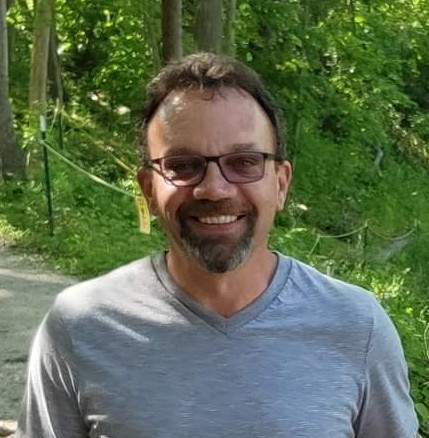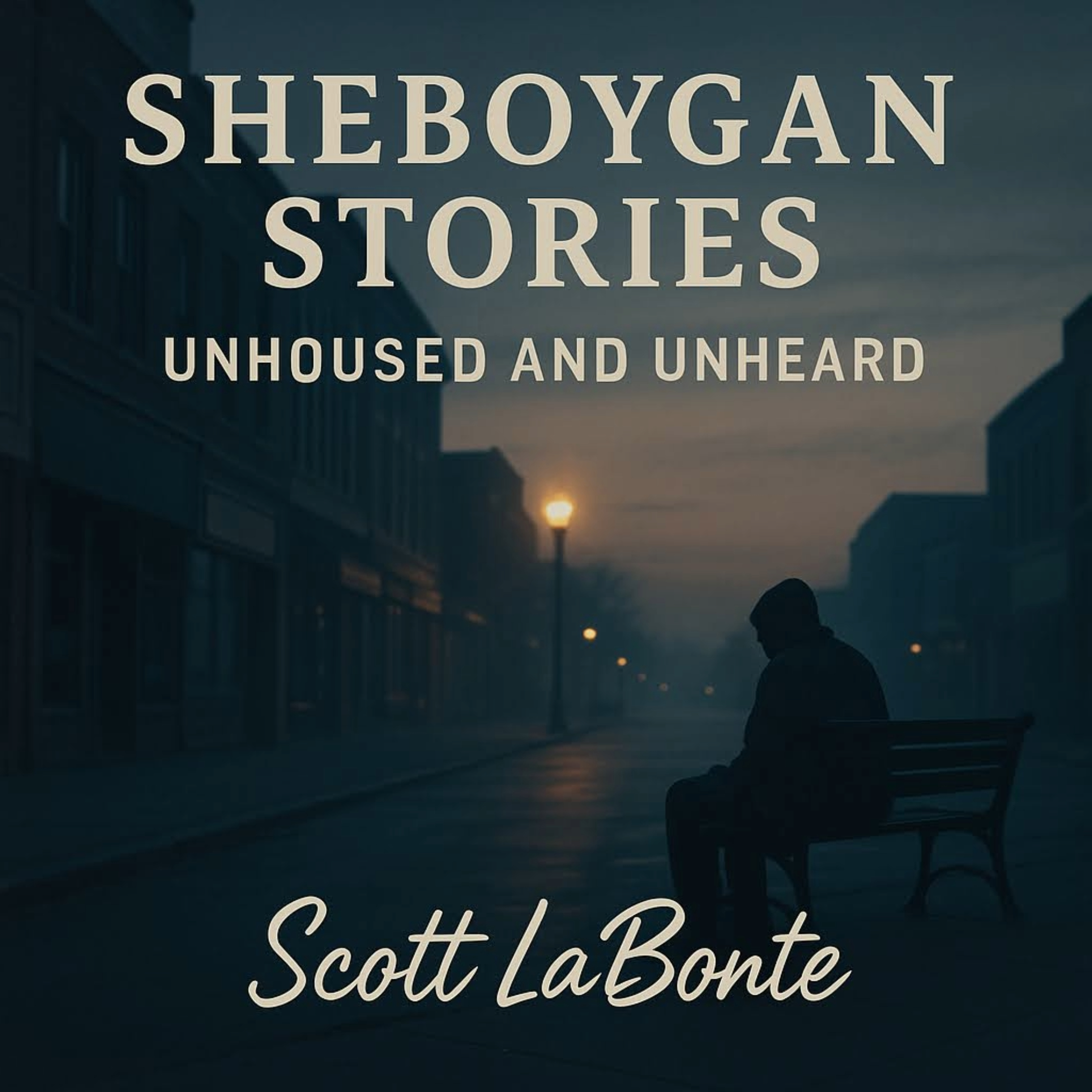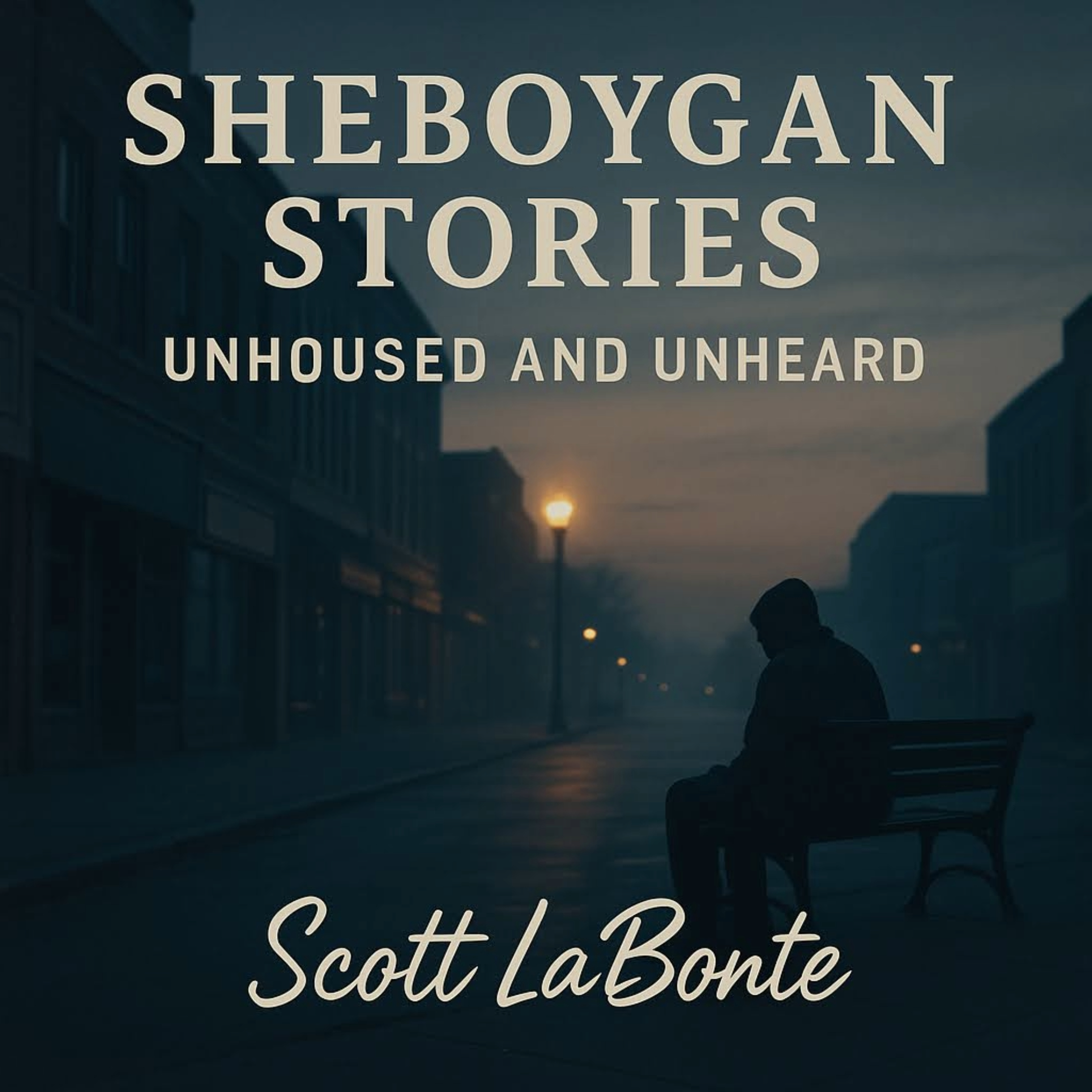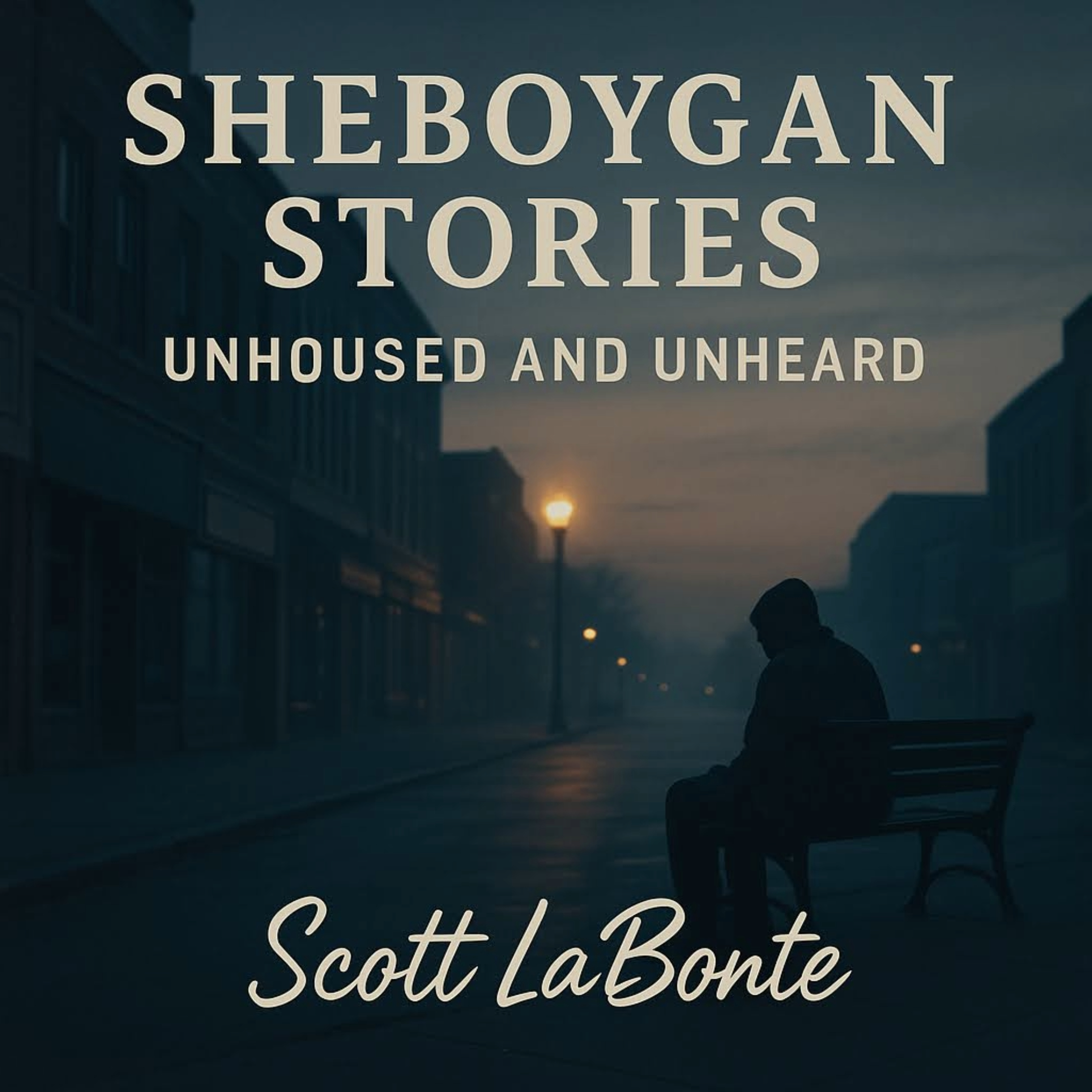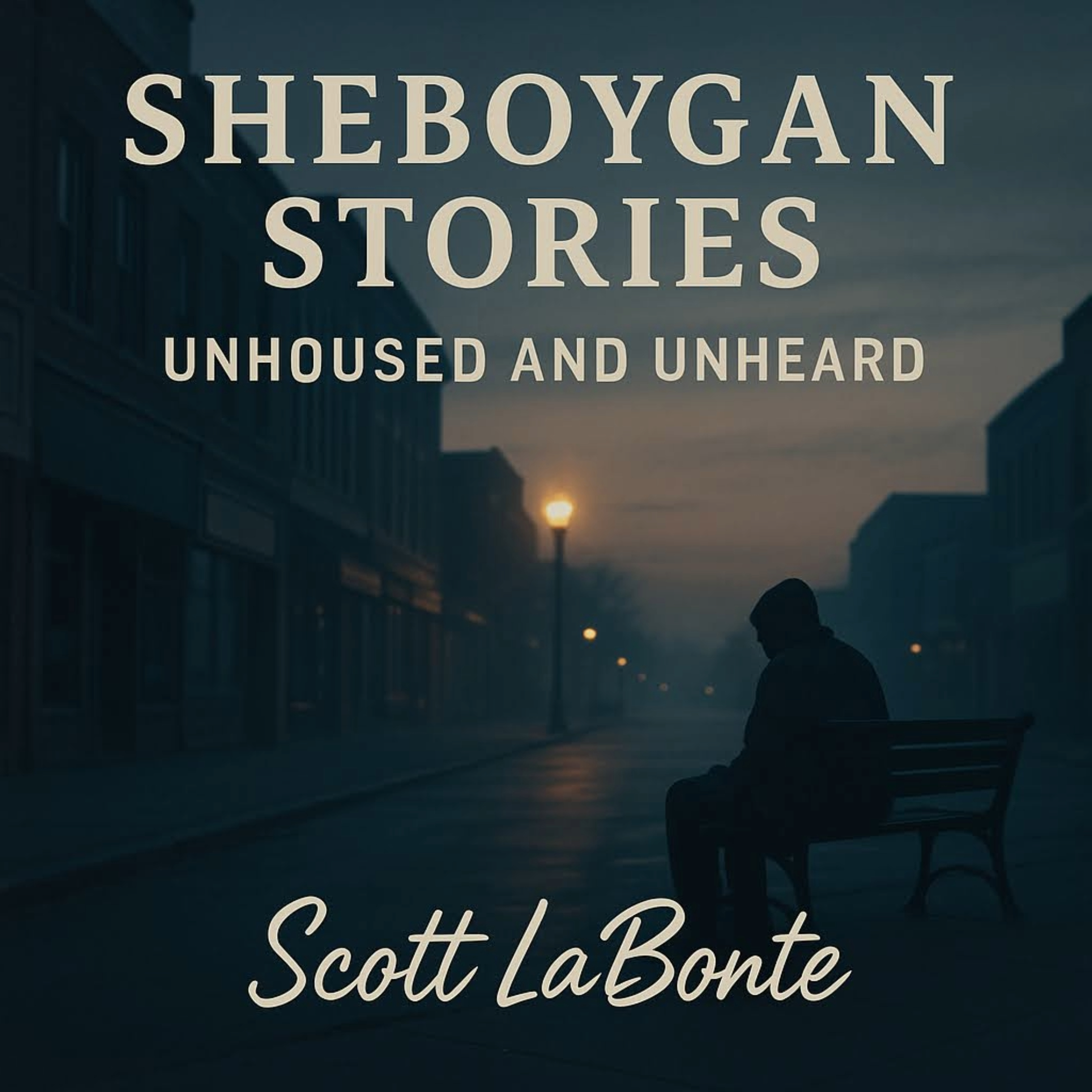Episode Transcript
[00:00:22] Speaker A: All right, welcome back to Sheboygan stories on how's it Unheard? I'm your host, Scott labonte, and. And as always, we're here to share real voices, real stories, and real resilience from right here in our own community.
Today's episode is one that hits close to home. It's about recovery, creativity, and the incredible power of art to heal.
My guest, Crystal, has been a friend of ours for quite a while. She's a huge help during Sunday lunches at Sheboygan area Pay it Forward. And she's gone on to do something really inspiring with her program called Art and Recovery.
Crystal works with several local organizations using art as a tool for healing, connection, and self discovery, especially for those who have been through some of the hardest chapters life can write.
So, for starters, thank you so much for being here.
All right, so start at the beginning. You've had quite the journey to get to where you are right now.
Tough upbringing, some time in prison, and then this amazing transformation through your art.
What started your journey with this art?
[00:01:23] Speaker B: Well, even when I was a young kid, I always liked art.
It wasn't until I was actually in a group home here in Sheboygan Hearthside that I did my very first art program as a kid.
And then years later, I went to work at Lighthouse Recovery center, and they offered me a.
Sorry. They offered me a position to work with the art and recovery, and I just. It kind of just flourished from there. I took off. I loved it. I loved working with peers, so I just kind of wanted to keep moving it forward.
[00:01:54] Speaker A: That is awesome.
So many of the people that we worked with are trying to rebuild their lives piece by piece. And it sounds like for you, art was one of those missing pieces, which is definitely cool.
When you look back now, what do you think was the turning point? Was there a moment when you decided, I'm done just surviving and I want to start living differently?
[00:02:14] Speaker B: Yes, that would be the moment that I tried to take my life. I was in a very, very bad position.
I didn't have my.
I didn't see them. I was just not in the right, I guess, mindset or even wanted to continue without my children. I didn't know what it was like to not take care of other human beings. So it really put me in a very dark place to the point where I was about to take my own life. I was about ready to leap off the bridge. And it was a friend that pulled me off to see me, somebody I haven't seen in years. And, you know, he kind of Sat down, listened to my story, and then I decided to dig in and started learning what going to different classes, learning about trauma, how to heal it, different things. I even took a class to kind of express myself in a poetic way. And so I started doing that with art and other things. And I just knew that I had to do something if I wanted to see my kids again and if I wanted to even, like, have some kind of substance of a life. Because I was like a shell.
[00:03:25] Speaker A: Right.
Wow.
So now you're using that story to help others, which is truly amazing, especially those in recovery. Can you tell us a little bit more about your art and recovery program?
[00:03:39] Speaker B: Yes.
So we have many peers from all over. I have some that are a lot that are in recovery, some that experience homelessness, a lot with mental health.
And again, it gives them a chance to actually meet new different people, find stuff that they like in a healthy and safe environment.
And it's great. Cause we have different things where sometimes we have events or programs, sometimes we donate it. I'm sure some of you are used to Koki, the foundation, the Positivity Foundation. So some of our peers love to donate their art as prizes for them as well as we've held different events and fundraisers where they get a chance to make money. And that money is they have to set up a goal. And it can be used for certain things, like application of fees for apartments. We had somebody that needed a special item for personal reasons, like a bra. And again, sometimes we can find things to help them, sometimes we can't.
So, you know, this gives them a little accomplishment while they're feeling down in the dumps and gets their goals going. So they have another way to process things.
[00:04:51] Speaker A: Right. So I absolutely love that you're not only creating art, but you're creating community.
[00:04:56] Speaker B: Yes.
[00:04:56] Speaker A: Which is huge.
You've got something a little bit.
I think while we're on that big going on with the Kohler Arts center right now.
[00:05:05] Speaker B: Yes. So this Saturday, they will be doing a community event and they'll be showing a whole bunch of artwork that many of our peers made from one to four.
We also got a chance to do some artwork with Lonnie.
[00:05:19] Speaker A: Lonnie Haller. Absolutely amazing guy.
[00:05:21] Speaker B: Yes. And it was a wonderful experience. And that was at the Warming Center, AKA the community Cafe.
They combined the two and it was awesome. We had so many people that came and joined out. It was very fun.
[00:05:34] Speaker A: I saw some of the pictures posted on Facebook. It looks absolutely incredible for so many people coming out of these tough situations. Addiction Homelessness, incarceration.
That sense of belonging can be even more healing than the art itself.
What are some of the organizations or groups that you're partnered with your Art and Recovery?
[00:05:56] Speaker B: Well, so I've done many things with House of Spiritual Vibes. That's my sister, Nina Soule. We've done things with the Pressy Bestie, the Sheboygan Visual Arts center that recently is, I guess, departed.
And then we also did Lighthouse Recovery Center, Pay It Forward, John Michael Kohler Arts center, the housing transitional unit.
I've worked with Marla Payne, and we've done some fundraisers with brick and mortar and Tricia Skyline.
[00:06:29] Speaker A: Way cool. And that's kind of how we got to know each other. Pay It Forward through, you know, coming in Lighthouse.
We had a lot of good times there.
[00:06:39] Speaker B: Yes.
[00:06:44] Speaker A: It's amazing how creativity can open doors to connection and recovery in ways that traditional approaches sometimes can't.
What are some of the biggest changes that you've seen in people who participate or even in yourself through this process?
[00:06:57] Speaker B: I've seen a lot of people first come to me and a little shy and, you know, a lot of them, I hear a lot. Exactly. Is I'm not an artist. Well, the I or art is I the beholder, you know, and there's so many different forms of artists. So again, I just don't stick to one drama, one dynamic. Sometimes we do. We can do music and integrate it with art. Sometimes we do painting, sculpting. We've done beadwork. We've done all types of different stuff.
Stained glass windows, making junk journals. And it's really cool to get to see people, like, try new things and always, oh, I didn't think. I like that. Or I'm not good, but I really like how that turned out. Or I really liked how that person is and just their accomplishment and getting. Seeing them every day and warming up and seeing new things and just stepping forward. We've had a lot of people, too, very, very excited, you know, that their art is being displayed at John Michael Kohler Art Center. They were so excited.
[00:07:51] Speaker A: That is way cool.
[00:07:53] Speaker B: We've also had so many people that got a sense of accomplishment, especially when we did events and selling some of their art and they got to actually finish some of their goals. Sometimes it can be hard when you are in transitional living or homeless and you feel like you're not making any progr progress because you're just really surviving, and then, you know, you want to do something, and maybe you just don't have the funds. And this Was just a way to help them out. And it. It's good to see them accomplish and just wanting to keep going and being that, like, light where they can see. Oh, yeah, I did something small. Even though it was small, it was worth it. And maybe if I can do it tomorrow or the next day, and the next day I might see more progress.
[00:08:34] Speaker A: And then you get to see the finished product after that. And you're like, I did that. You know, which is way cool, because I am, I can admit I am one of those people that say, I'm not an artist. I'm stick people. You know, that's about the extent of my ability. I do use the music quite a bit, so I guess there is a form of that.
But that is way cool.
So if you get the inclination, even if you don't think you're an artist, stop by, say hi, pop in. You never know, you might really like it.
Is there anything else you want to add?
Anything you want to tell anybody about anything? I guess Mike is yours, and then we'll wrap it up.
[00:09:16] Speaker B: I guess one thing, you know, even if you think you can't make it, there's been days, trust me, you've even heard me talk about how there was a day I was going to try and kill myself.
You know, one of the weirdest things is the person that pulled me away as their kid came out and gave me the. Wanted us me to read the little the choo choo train. I think I can. I think I can. And from that day forward, like, sometimes even when I'm struggling with my own just health or sobriety or just things, I, you know, I sit back and I have to laugh and I'll just sit there like I'm a choo choo train. And I'll be like, I think I can, I think I can. And for some reason, for me, that just gives me a little courage and makes me feel better so that I can just get up and do it the next day.
So that's just something that always, like, kind of inspired me. So, you know, even when you don't think you can do something, just keep telling yourself, I think I can. I think I can. You never know how far you might make it, Right?
[00:10:10] Speaker A: Baby steps, right? You know, and I talk about that actually quite a bit on this, you know, especially with dealing with some of our peers and stuff.
Yes, we know what the end goal is. You know, the end goal, you want to be in your own place. You want to have, you know, a place to call home.
But that's huge. Looking at that can be daunting, you know, and scary.
You know, there's a lot between where you are now and where you envision yourself being.
And I try to tell everybody a lot. Look at what's in front of you right now. What can you fix? What can you take care of that's immediately in front of you?
And then when that's done, then you move on to the next thing. Even if they're just baby, just incremental little steps, it's still progress, right?
[00:10:58] Speaker B: It can be overwhelming. And just to know where to start, that just sometimes just the little things can get you going, right?
[00:11:04] Speaker A: Oh, absolutely. You know, and oftentimes, you know, and I guess I'm just as guilty of that as well, you don't even want to take that first step because you're thinking, man, that's a whole lot to get done.
But if you just check those boxes one at a time, little steps by, you know, each time it's gonna get done and you're gonna get. And before you know it, you look back going, shit, I did that, right? I actually did that. I made it, you know, and, you know, and then you can. Well, sometimes you can look back and say, was, it wasn't as bad as I thought it was, or.
Or sometimes, holy shit, that was tough.
[00:11:40] Speaker B: Yes.
I mean, there are many times where, like I said before, that I didn't even think or even picture that I'd ever get my kids back. I'd be able to see them or hold them again and hug them. And, you know, here I am, I have them. I'm doing an art program. I get to see many people flourish. So it's a wonderful process, you know, it truly is.
[00:12:03] Speaker A: I'm not sure that I would deal well with that, not knowing if you get to see your kids again or, you know, if you get to hug them. You know, you said, get to hug them, and that struck that hit. I was like, ouch.
I don't know.
[00:12:18] Speaker B: For me, that day, the breaking point was, and this may sound silly to some, was I could no longer remember my kids scent. No, they didn't smell like that. But you know, your kids, even when they're babies, they have that.
Their own smell. And I wasn't able to hold them or see them or talk to them for a good year. And I just. I couldn't smell them anymore. It's like I couldn't even picture them. And I just. I don't know. Like I said, I couldn't imagine at that time not Being a mom, even when I was a young kid, you know, I took care of my siblings because my parents were addicts and never around. So I was so ingrained into taking care of people that, like, it was so scary not to have somebody to take care of. And I had to focus on myself, which was something I was not used to.
[00:13:09] Speaker A: So that's a huge adjustment.
[00:13:11] Speaker B: It was very overwhelming. And like I said, that straw was just kind of.
I couldn't smell them, so I thought, like, I forgot them. So I thought I was just this horrible person because I forgot them, because my mental was so out there. Like, I couldn't picture them. So I didn't want to live.
But, you know, it was crazy as I was about to jump, as you know, I made a little prayer to God and somehow, like I said, an old friend just came and out of nowhere caught me. And then things kind of changed for the better. Well, a lot better.
[00:13:42] Speaker A: But, yeah, everything happens for a reason.
[00:13:44] Speaker B: Oh, yes.
[00:13:45] Speaker A: Wow.
So I guess I know you kind of hit a little bit, but what would you say to somebody listening right now who's in that dark place that you once were, maybe struggling with addiction or just feeling like there's no way forward?
[00:14:01] Speaker B: It sounds funny, but again, I would just keep repeating to myself, you know, that was one thing that, like I said, just struck me. Maybe because it was a kid and because my kids got taken away from me, but I just kept saying to myself, as I think I can, I think I can. I think I can. Even when there were times I didn't want to, but I did it. And somehow, you know, I was able to do a lot more and create a program and offer a lot to people to express themselves. When sometimes, you know, all you want to do is smash things or cry or be depressed. It's another outlet for them to express their feelings and to even forget sometimes for just that few minutes, to have happiness and see people have that same kind of happiness when they see your art. Sometimes, for me at least, you get to.
The world kind of melts away, so you don't think about all that and you're not as stressed. And it kind of gives you just a relief, even if it's for a second.
[00:15:00] Speaker A: And that's a huge step in the healing process.
[00:15:02] Speaker B: Yes.
[00:15:03] Speaker A: Really. You know, even just getting it out there, or as you said, just everything melts away, and. And there's really nothing there at that point that's. That's weighing you down or really, you know, dragging you. It just gone. And you can be Free and be you.
[00:15:22] Speaker B: Yes.
[00:15:23] Speaker A: Nice.
So anybody that's listening out there, you know, again, the art and recovery program, give it a shot. Stop in. Say hi to Crystal. She's pretty cool, you know, she doesn't bite. Honest. Or at least not very hard.
I guess I don't, you know, I don't really have a whole lot. I just wanted to kind of get your word out there, get. Get your program a little bit more known.
I want people to see the good that you're doing, the help that you're. You're giving this community and moving people forward and really working on that healing process on them. And you, I guess, you know, and I guess to thank you for everything that you've done for Pay it Forward.
And we really appreciate it.
[00:16:12] Speaker B: It was an awesome time, a very good experience.
I loved it. And I still get to see many of those peers. They've kind of joined at many different art things that I'm in now. So it is awesome.
[00:16:23] Speaker A: That is incredible. There's some pretty amazing people out there in that community.
[00:16:27] Speaker B: Lots of talent.
[00:16:28] Speaker A: There really is. We had that one wall, the I beam that ran across that. We used to have those little five by seven canvases or whatever that everybody used to. And some of the stuff they put out on there, I was like, damn.
You know, just impressive.
[00:16:43] Speaker B: Yes.
[00:16:44] Speaker A: You know, and I think it gave too, that sense of, you know, every time they were there, they're looking at like, I did that. Yes. Right. That's mine. I did that. I got that up.
[00:16:55] Speaker B: And just to see their smile too, and it's awesome. Like I said, we got a sneak peek Friday for the con or yesterday for the concert at John Michael Kohler Art center, and one of the peers from Lighthouse Recovery center was there and their art piece was up there and they were just.
Their smile just kind of said it all. It was awesome.
So I highly suggest if you want to see lots of beautiful art, It's Saturday from 1 to 4 at John Michael Cola Art Center. We also do have some art for some of our old Pay it Forward clients at the library. On Thursdays, we will be at the warming center and community cafe as well as the housing transitional unit off of Superior Manor.
[00:17:36] Speaker A: Right. That is awesome.
All right, so thank you so much for joining me today and thank you for everything you continue to do in our community. You are proof that healing doesn't just happen. It's built one stroke at a time.
If you'd like to learn more about art and recovery or get connected with Crystal's work, we'll include links and contact information in the episode description. I'll figure a way to have that happen.
And as always, thank you for listening to Sheboygan stories on How's It Unheard? And if this episode moved you, please share it. Follow the show on your favorite podcast platform and help us continue to amplify Voices that Matter. Until next time, keep your heart open and pay it forward.
